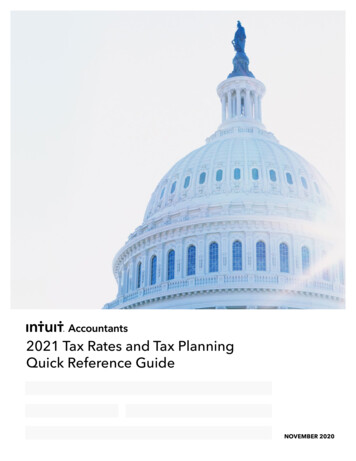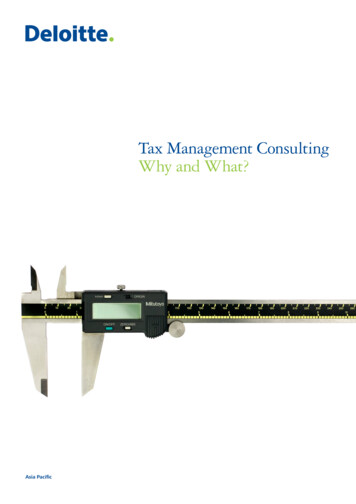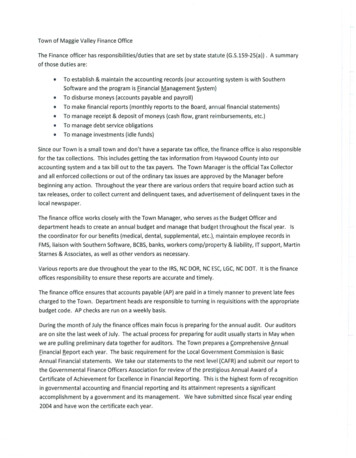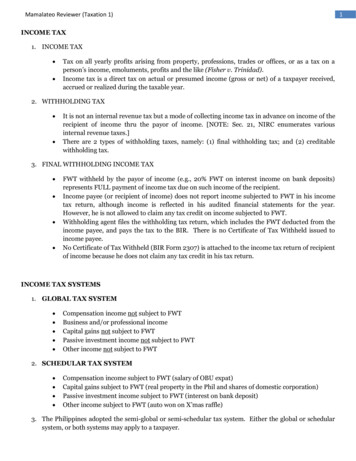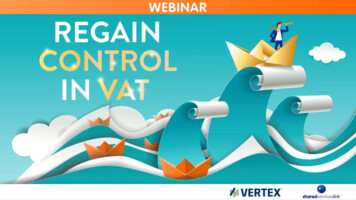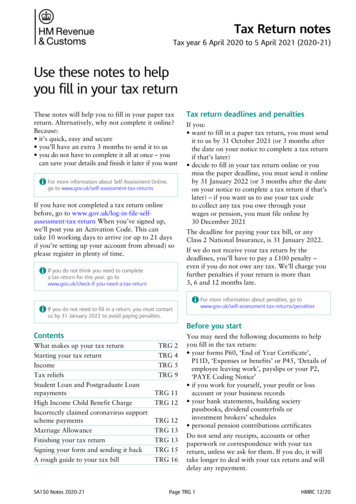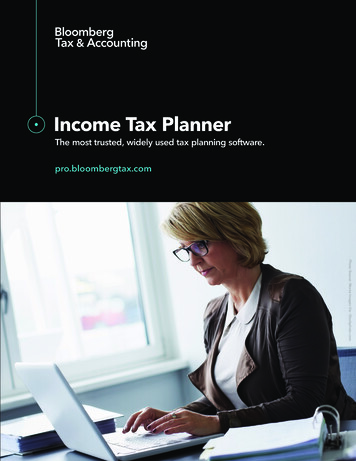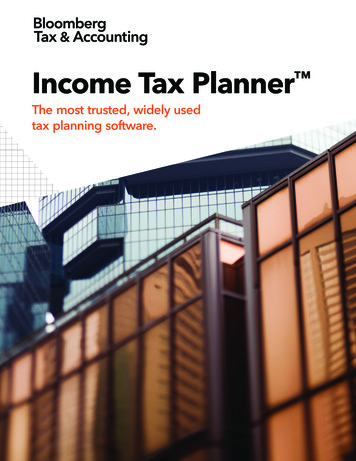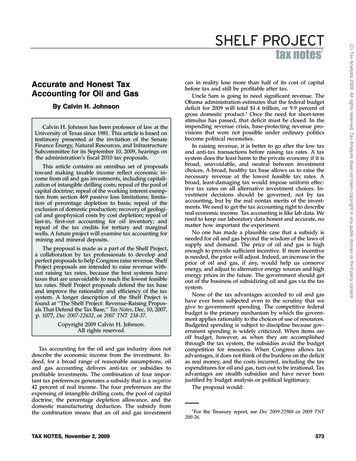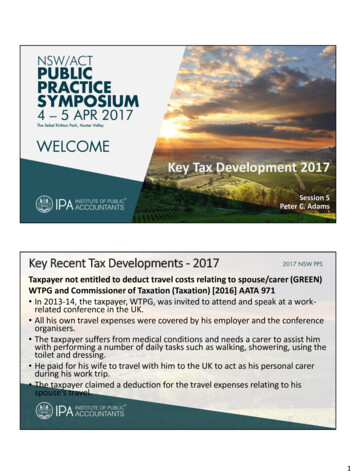
Transcription
Key Tax Development 2017Session 5Peter C. AdamsKey Recent Tax Developments - 2017Taxpayer not entitled to deduct travel costs relating to spouse/carer (GREEN)WTPG and Commissioner of Taxation (Taxation) [2016] AATA 971 In 2013-14, the taxpayer, WTPG, was invited to attend and speak at a workrelated conference in the UK. All his own travel expenses were covered by his employer and the conferenceorganisers. The taxpayer suffers from medical conditions and needs a carer to assist himwith performing a number of daily tasks such as walking, showering, using thetoilet and dressing. He paid for his wife to travel with him to the UK to act as his personal carerduring his work trip. The taxpayer claimed a deduction for the travel expenses relating to hisspouse’s travel.1
Tax UpdateLump sum workers’ compensation payment derived in year receivedEdwards v FCT [2016] AATA 781 In 2014-15, the taxpayer received a lump sum payout as statutory workers’compensation for incapacity. The payment related to 2000-01 to 2005-06. The taxpayer, Mr Ian Edwards, left his job with the Australian Federal Police(AFP) in 2000 and commenced part-time work as a photographer in 2006. He had sustained injuries in the course of his employment with the AFP. In February 2015, as a result of an earlier AAT decision, the taxpayer was paida gross lump sum payment of 86,088.77 by Comcare, pursuant to the Safety,Rehabilitation and Compensation Act 1988 (SRC Act). Broadly, the payment was a compensation for incapacity, and it related to theperiod from 30 November 2000 to 26 April 2006.Tax UpdateLump sum workers’ compensation payment derived in year receivedEdwards v FCT [2016] AATA 781 A private ruling confirmed that the lump sum payment was assessable in theyear in which it was received. The taxpayer lodged his 2014-15 income tax return, including the lump sumpayment as assessable income. The Commissioner subsequently issued a notice of assessment reflecting theself-assessed taxable income and allowing a tax offset for lump sum paymentin arrears (LSPIA tax offset). The AAT held that the entire lump sum was derived, and therefore assessable,in 2014-15 and not in the earlier years.2
Tax Update - Tax Residency The “backpacker tax” legislative package finally passed both Houses of Parliament, after muchdebate and a number of amendments. The Acts received Royal Assent on 2 December. Working holiday makers are foreign workers on visa sub-class 417 and 462. Tax rates for working holiday makers, from 1 January 2017, are: 1. Does not exceed 37,000 - 15%2. Exceeds 37,000 but does not exceed 87,000 - 32.5%3. Exceeds 87,000 but does not exceed 180,000 - 37%4. Exceeds 180,000 - 45% Employers of working holiday makers must register with the ATO. The ATO has issued a separate withholding schedule. Registration for employers already employing working holiday makers were required to register by31 January. Employers that intend to hire working holiday makers will need to register with the ATO. Penaltiesmay apply for failing to register.Tax UpdateReview of substantiation exception for travel expense deductions The ATO has released a consultation paper in relation to improving itsadministration of the substantiation exception for reasonable travelallowance expenses. The ATO reports a disparity between travel allowances paid anddeductions claimed for accommodation, meals, and incidentals. This has increased the incidence of checking of these claims, whichhas highlighted deficiencies and difficulties for employees in showingthe amount claimed was incurred, or was incurred in gaining orproducing their assessable income.3
Tax UpdateReview of substantiation exception for travel expense deductions The ATO acknowledges that there is a lot of confusion in the taxpayercommunity about how to apply the substantiation exception. Therefore it has released a consultation paper and seeking feedbackon how it can improve its guidance and administrative practices inrelation to the substantiation exception. Submissions are due by 22 November 2016.Tax UpdateInteraction between royalties and business profits Articles Tech MahindraLimited v Commissioner of Taxation [2016] FCAFC 130 This Full Federal Court decision concerns the Australia-India double taxtreaty and the interaction between the business profits rule (Article 7)and the royalties provision (Article 12). The taxpayer is a resident of India which carries on business inAustralia through a permanent establishment. During the relevant year, the taxpayer performed services for itsAustralian customers both in Australia and in India.4
Tax UpdateInteraction between royalties and business profits Articles TechMahindra Limited v Commissioner of Taxation [2016] FCAFC 130 The Full Court held that certain categories of payments referrable to theservices performed in India were ‘royalties’ for the purposes of Article 12. By application of Article 12(4), where the ‘property, right or services’ inrespect of which the royalties are paid are ‘effectively connected’ with apermanent establishment in Australia, those royalties will be taxed under thebusiness profits Article. The Full Court concluded that the royalties were not ‘effectively connected’with the Australian permanent establishment. Therefore, the taxpayer was subject to Australian tax under Article 12 on thegross value of the royalties, and not under Article 7 on the net amount afterrelated deductions.Tax UpdateExcess super contributions - special circumstances found onappeal Ward v Commissioner of Taxation [2016] FCAFC 132 The Full Federal Court overturned a AAT decision not to disregard thetaxpayer’s excess non-concessional contributions of 450,000 or toallocate them to another financial year. The circumstances were that the taxpayer, through misunderstandingsinvolving his new and old advisers, exceeded the three year bringforward limit. The Court held that the ATT erred in determining that the excesscontributions tax (ECT) was the natural and foreseeable consequenceof the decisions of the taxpayer and his advisers. By doing so, the AAT put the imposition of the ECT outside the scope of“special circumstances”.5
Tax UpdateRegistration terminated – Code applies to personal conduct Kishore andTax Practitioners Board [2016] AATA 764 The AAT has affirmed the TPB’s decision to terminate the applicant’stax agent registration. The applicant, who was a registered agent, left his employer, whichprovided tax agent services. The TPB was satisfied that the applicant had breached s30-10 of theTASA by not acting honestly and with integrity towards the formeremployer around the time he left the firm.Tax UpdateRegistration terminated – Code applies to personal conduct Kishore andTax Practitioners Board [2016] AATA 764 The AAT was of the view that the Code of Professional Conduct of theTASA applies to all aspects of a person’s conduct as a registered taxagent, whether that conduct be personal conduct as a registered taxagent, or professional conduct as a registered tax agent. The Code cannot be confined in its application, so as to require honestyand integrity only in relation to the provision of tax agent services6
Tax UpdateNew residential premises: Properties did not satisfy ‘five year’ ruleFKYL and Commissioner of Taxation (Taxation) [2016] AATA 810 The taxpayer carried on a house construction business as a sole trader. She enteredinto building contracts to construct four residential properties on vacant blocks. The taxpayer did not claim any input tax credits (ITCs) for the purchases of theproperties. She also claimed that they were purchased under the margin scheme. At the time that the taxpayer lodged her application with the AAT, she had notprovided the ATO with written agreements which were necessary to show that themargin scheme applied. The properties were rented upon completion and then sold. The lease agreements provided that the tenants were to purchase the properties,and could rent the properties while saving for the depositTax UpdateNew residential premises: Properties did not satisfy ‘five year’ ruleFKYL and Commissioner of Taxation (Taxation) [2016] AATA 810 The taxpayer was of the view that the sales of the other three properties werenot taxable supplies, and therefore not subject to GST, because they were allpurportedly more than 5 years old when they were sold. The ATO disagreed with the taxpayer. The ATO was of the view that the property sales should be treated as sales ofnew residential premises and therefore subject to GST. Further, the ATO said that she was not entitled to use the margin scheme andconsequently calculated her GST liability as 1/11 of the sale proceeds. The ATO allowed the taxpayer to claim some ITCs for construction costs andnon-construction costs, to the extent that they did not relate to the periods ofrent.7
Tax UpdateNew residential premises: Properties did not satisfy ‘five year’ ruleFKYL and Commissioner of Taxation (Taxation) [2016] AATA 810 Under the terms of s40-75 of the GST Act, a supply of residential premises is subject to GSTif the premises have only been used for making supplies of residential rent (which are inputtaxed supplies) for a continuous period of at least 5 years since: the premises first became residential premises, where the premises have not previouslybeen sold as residential premises the premises were last substantially renovated, where the premises have been createdthrough substantial renovations of a building; or the premises were last built, where the premises have been built, or contain a buildingthat has been built, to replace demolished premises on the same land. After the 5 years of that sole usage, the residential premises lose their ‘new’ status. This is known as the 5 year rule.Tax UpdateNew residential premises: Properties did not satisfy ‘five year’ ruleFKYL and Commissioner of Taxation (Taxation) [2016] AATA 810 As noted the taxpayer constructed four properties and rented them outbefore selling them to the tenants. The AAT concluded that the properties were ‘new residential premises’ andtherefore subject to GST. The properties satisfied the definition of new residential premises as theycould not be said to have only been used for residential rent for at least fivecontinuous years preceding the supply. Further, the margin scheme could not apply as the taxpayer could not showthe written agreements with the purchasers that the margin scheme shouldapply.8
Tax UpdateFleet cars: simplified approach for calculating car fringe benefitsPCG 2016/10 Fleet Cars: simplified approach for calculating car fringe benefits PCG 2016/10 provides an optional, simplified approach to working out thebusiness use percentage component of the operating cost method to work outthe taxable value of car fringe benefits in relation to fleet cars. This simplified approach is available for employers with a fleet of 20 or morecars and allows these employers to rely on a representative average businessuse percentage to calculate car fringe benefits for the fleet under theoperating cost method.Tax UpdateFleet cars: simplified approach for calculating car fringe benefitsPCG 2016/10 Fleet Cars: simplified approach for calculating car fringe benefitsThe guideline is applicable to an employer if all following criteria are met: the employer has a fleet of 20 or more cars the cars are 'tool of trade' cars employees are mandated to maintain log books in a log book year valid log books are held for at least 75% of the cars in the log book year the cars are of a make and model chosen by the employer, rather than the employee each car in the fleet had a GST-inclusive value less than the luxury car limitapplicable at the time the car was acquired, and the cars are not provided as part of an employee's remuneration package (forexample, under a salary packaging arrangement), and employees cannot elect toreceive additional remuneration in lieu of the use of the cars.9
Tax UpdateFleet cars: simplified approach for calculating car fringe benefitsPCG 2016/10 Fleet Cars: simplified approach for calculating car fringe benefitsThe simplified, average business use percentage is calculated by: gathering all log books kept for each car in the fleet Determining which of those log books are valid confirming that valid log books are held for at least 75% of the cars in thefleet, and calculating the average of the business use percentages determined inaccordance with each of the valid log books. The simplified approach can be applied for a period of five years.Tax UpdateIndustry severance scheme is not a unit trust (GREEN)ElecNet (Aust) Pty Ltd v Commissioner of Taxation [2016] HCA 51 The taxpayer is the trustee of the Electrical Industry Severance Scheme (the EISS). Under the EISS, employers within the electrical contracting industry may becomemembers of the scheme and become obliged to make payments to the taxpayer inrelation to their employees. These payments are credited by the taxpayer to accounts in the names of therelevant employees. The Trust Deed contemplates that, at such time as an employee’s employment isterminated, the taxpayer is to make a severance or redundancy payment to thatemployee. The Commissioner issued a private ruling stating the view that the taxpayer is not a“public trading trust” for the purposes of Div 6C of the ITAA36. One of the grounds for this conclusion is that the EISS is not a “unit trust” within themeaning of Div 6C.10
Tax UpdateIndustry severance scheme is not a unit trust (GREEN)ElecNet (Aust) Pty Ltd v Commissioner of Taxation [2016] HCA 51 The High Court has held that an industry severance scheme is not a unit trustfor the purposes of Division 6C of Pt III of the ITAA36 Accordingly it is not a public trading trust, and therefore the trustee is noteligible to be taxed at the company tax rate. The primary reason for this conclusion is that the beneficial interest in thescheme (the trust estate) is not divided into units.Tax UpdateTaxpayer not entitled to deduct travel costs relating to spouse/carer (GREEN)WTPG and Commissioner of Taxation (Taxation) [2016] AATA 971 In 2013-14, the taxpayer, WTPG, was invited to attend and speak at a workrelated conference in the UK. All his own travel expenses were covered by his employer and the conferenceorganisers. The taxpayer suffers from medical conditions and needs a carer to assist himwith performing a number of daily tasks such as walking, showering, using thetoilet and dressing. He paid for his wife to travel with him to the UK to act as his personal carerduring his work trip. The taxpayer claimed a deduction for the travel expenses relating to hisspouse’s travel.11
Tax UpdateTaxpayer not entitled to deduct travel costs relating to spouse/carer (GREEN)WTPG and Commissioner of Taxation (Taxation) [2016] AATA 971 The ATO disallowed the deduction under s8-1 on the basis that the expenseswere of a private or domestic nature. Further, s26-30 denies a deduction for the travel costs of a relative whoaccompanies a taxpayer on work-related travel. The taxpayer submitted that denying the taxpayer a deduction constituteddiscrimination under the Disability Discrimination Act 1992 (Cth) (DDA) andthat s26-30 is inconsistent with the DDA.Tax UpdateTaxpayer not entitled to deduct travel costs relating to spouse/carer (GREEN)WTPG and Commissioner of Taxation (Taxation) [2016] AATA 971 The AAT has decided that a taxpayer suffering from medical conditions andrequiring daily personal care is not entitled to deduct travel costs incurred sothat his wife could accompany him on a work-related trip as his carer. The deduction was denied under s8-1, although s26-30 would also haveapplied. The cost were viewed as private and domestic under section 8-1 and relativerelated expenditure under s26-30 Further, the denial of the deduction did not constitute discrimination underCommonwealth law.12
Tax UpdateTrust resolutions held to be valid (GREEN) - TVKS v FCT [2016] AATA 1010 The individual taxpayer was a beneficiary of the Woodchester No. 4 Trust and the BristolTrading Trust. In May 2013, the Commissioner issued amended assessments to the taxpayer for 200506and 2006-07. The Commissioner increased her taxable income from 9,000 to 10.1 million for 2005-06,and from 9,500 to 3.2 million for 2006-07. The Commissioner made the amendments as a result of increases to the trusts’ netincomes, which were distributed to the taxpayer. Archer Property Pty Ltd (Archer Property) was the trustee for the Woodchester No. 4 Trust. On 30 June 2006, Archer Property resolved to distribute 100% of the “income of the trust,as defined in the deed” for the income year ended 30 June 2006 to the taxpayer (ArcherProperty Resolution). In December 2015, the taxpayer executed a “Disclaimer of Entitlement to Income” inrespect of each trust. The documents stated that she disclaims and rejects absolutely any entitlement to anyincome, capital or gift from the trusts, from 1 July 2005.Tax UpdateTrust resolutions held to be valid (GREEN) - TVKS v FCT [2016] AATA 1010 The AAT considered a number of issues. These include: whether the taxpayer’s deeds of disclaimer are effective to prevent her being presentlyentitled to the net income of the two trusts whether the Archer Property Resolution was ineffective as the trust deed onlypermitted Archer Property to distribution “Net Income”.13
Tax UpdateTrust resolutions held to be valid (GREEN) - TVKS v FCT [2016] AATA 1010 The AAT handed down a decision that these particular distributions from d onthe basis trusts comprise assessable income of the beneficiary taxpayer This was held on the basis that the taxpayer’s purported disclaimers ofinterest were invalid, and that the trust resolutions were effective indistributing the income to her.Tax UpdateUPE written off as bad debt is not deductible - TD 2016/19 TD 2016/19 sets out the Commissioner’s view that a beneficiary of a trust isnot entitled to a deduction under s25-35 of the ITAA97 for an amount ofunpaid present entitlement (UPE) to trust income that the beneficiarypurports to write off as a bad debt. In the TD, a UPE is a beneficiary’s right to receive an amount of trust incomeand/or capital that:a. arises as a result of the beneficiary having been made presently entitled tothat amount, andb. has not been satisfied (including by being paid to or as directed by thebeneficiary, or by being effectively converted into a loan from thebeneficiary) or effectively disclaimed.14
Tax UpdateFuel disbursements included in aggregated turnover - Doutch v FCT [2016]FCAFC 166 The taxpayer, which operates an oil and gas drilling business, receivedamounts from clients in respect of fuel disbursements associated with drillingwork. The Full Federal Court held that the amounts formed part of the taxpayer’saggregated turnover for the purposes of the small business CGT concessionseligibility tests. The fuel disbursements were ordinary income derived in the ordinary courseof carrying on a business.Tax UpdateHome office expenses on floor area basis - HWZG v FCT (Taxation) [2016] AATA1017 The AAT has affirmed the Commissioner’s decision on the deductibility of ataxpayer’s home office expenses. In order to arrive at a “fair and reasonable” apportionment on a floor areabasis, it was necessary to include the taxpayer’s driveway and correspondingopen carport area in the “total floor area”. Where areas of a property are used for business purposes and included in thefloor area related to the income earning activity, then it is “fair andreasonable” that similar or equivalent areas of the property that are used forprivate purposes are included in the “total floor area”.15
Tax UpdateIncrease to penalty unit In its MYEFO 2016-17, the Government announced that the CommonwealthPenalty Unit will increase from 180 to 210 on 1 July 2017. It will be indexed every three years in line with CPI.Tax UpdateA new Black Economy Taskforce The Government has announced that it has established a whole ofgovernment taskforce to crackdown on the black economy. Typically, the black economy refers to people who operate entirely outside thetax system or who are known to tax authorities but deliberately misreporttheir tax (and superannuation) obligations. The black economy can also include those engaged in organised crime. The Black Economy Taskforce will provide an interim report to Government inMarch 2017 and a final report in October 2017.16
Tax UpdateCertainty letters for 2016 Since November, the ATO has been sending certainty letters to someindividuals to confirm their 2016 tax return is finalised. The ATO will not conduct further review or audit of their tax return, buttaxpayers are still required to keep their tax records.Tax UpdateWork-related expense deduction risk profiles The ATO has developed work-related expense deduction risk profiles for taxpractices based on a comparison of the practice’s clients’ work-relatedexpense claims with those made by similar taxpayers. The ATO will share these risk profiles with some tax professionals where theirclients’ claims appear higher than expected.17
Tax UpdateCommissioner’s new “Remedial Power”Tax and Superannuation Laws Amendment (2016 Measures No. 2) Bill 2016The Commissioner can only exercise the Remedial Power (to modify law) where: the modification is not inconsistent with the intended purpose or object ofthe provision; the Commissioner considers the modification to be reasonable, having regardto both the intended purpose or object of the relevant provision and whetherthe costs of complying with the provision are disproportionate to achievingthe intended purpose or object; and the Department of the Treasury or the Department of Finance advises theCommissioner that any impact on the Commonwealth budget would benegligibleTax UpdateCommissioner’s new “Remedial Power”Tax and Superannuation Laws Amendment (2016 Measures No. 2) Bill 2016 Before exercising the power, the Commissioner must be satisfied that anyappropriate and reasonably practicable consultation has been undertaken. This allows an opportunity to identify and consider all implications from theexercise of the power and to ensure that the exercise of the power isappropriate in the circumstances. This is consistent with the approach to amendments of primary legislation,which are subject to public consultation. In addition, the Commissioner will consult with a technical advisory group(which will include private sector experts, the Treasury and the ATO) and theBoard of Taxation prior to any exercise of the power. According to the EM,Parliament expects18
Tax UpdateCommissioner’s new “Remedial Power”Tax and Superannuation Laws Amendment (2016 Measures No. 2) Bill 2016 A modification does not apply to a taxpayer if it would produce a less favourable result for them, or for anyother taxpayer. According to the EM, ‘favourable’ could mean either that: a tax liability is reduced, or the costs of complying with the taxation law are reduced, or overall, taking into account changes in liabilities and compliances costs, the modification is favourable. A taxpayer needs to self-assess whether a modification is less favourable to it, and whether it must thereforetreat the modification as not applying to itself and to any other entity.Tax UpdateDeduction for tools could not be substantiatedIshaq and Commissioner of Taxation (Taxation) [2017] AATA 35 (17 January2017) The taxpayer was employed as an aircraft maintenance engineer with anairline. After qualifying as a tradesman, he decided to buy his own tools, as the onesprovided by the employer were insufficient. He acknowledged that the employer had a tool crib comprising of large toolscalibrated for the specific planes, which would be loaned to the workers asappropriate.19
ax UpdateDeduction for tools could not be substantiatedIshaq and Commissioner of Taxation (Taxation) [2017] AATA 35 (17 January 2017) The taxpayer searched for tool sets on Gumtree and found ‘snap-on tools’ that he wantedto purchase, advertised for 28,000. He phoned the vendor, a Mr Owen Shaw, and negotiated a price of 24,750. The taxpayer claimed that the transaction took place at his home in September 2013 andthat he paid for the tools in cash from his gambling winnings, which he kept at home. The taxpayer also said that Mr Shaw prepared and provided him with a ‘tax invoice’ for thesale of the tools. The ‘tax invoice’ was handwritten with Mr Shaw’s contact details and a description of thetools. The taxpayer stated that he sold the tools in November 2015 as he no longer needed themfor work. The taxpayer claimed the cost of the tools as a tax deduction. The Commissioner disallowed the deduction.Tax UpdateDeduction for tools could not be substantiatedIshaq and Commissioner of Taxation (Taxation) [2017] AATA 35 (17 January 2017) The AAT did not allow a deduction for the cost of the tools.The taxpayer failed to discharge his onus of proof as to the excessiveness of the Commissioner’s assessment.The AAT was not satisfied that the taxpayer incurred any expense in purchasing ‘snap-on’ tools.The taxpayer also did not persuade the AAT that it was necessary for him to purchase ‘snap-on’ tools for hisline of work. The taxpayer did not produce any independent evidence with respect to the ‘snap-on’ tools. For example: there was no record of the Gumtree advertisement; There were no photos of the ‘snapon’ tools; Nor did the taxpayer produce any witness statements of people who may have sighted the tools at his workplace.20
Tax UpdateNo deduction for overtime meal expenses – no allowanceKael and Commissioner of Taxation (Taxation) [2017] AATA 38 (20 January 2017) The taxpayer was emplyed by a building business. He worked during the day on building sites and did paperwork in the evenings. He often worked on weekends. Before the beginning of each income year, the employer would set the taxpayer’s salary forthat year. The starting point of the calculation was an amount greater than the relevant salary underthe relevant industrial award. The salary also included an amount to cover regular overtime, an amount for work done athome, an amount to cover out-of-pocket expenses, and an amount for the taxpayer to usehis car for work purposes. The taxpayer was paid a fixed amount weekly. At the end of each income year, when the taxpayer’s tax return was prepared, an estimatewas made of how much overtime he had actually worked during that year and(commensurately) how much he had spent on food and drink to do with that overtime.Tax UpdateNo deduction for overtime meal expenses – no allowanceKael and Commissioner of Taxation (Taxation) [2017] AATA 38 (20 January 2017) The taxpayer claimed deductions for work-related expenses, relevantly includedovertime meal expenses. He claimed that he received an “allowance” under the award to buy food or drink todo with overtime. The AAT concluded that the taxpayer was not entitled to claim any deductions forovertime meal expenses. The law (s32-50) only permits a deduction for overtime meal expenses if thetaxpayer was paid an allowance under an industrial instrument to buy the food ordrink. The AAT found that the taxpayer did not receive an allowance under the relevantindustrial award. In fact, he did not receive an “allowance” at all, under an award or otherwise. The taxpayer’s salary was not calculated under the award: the award base salarywas used only as a starting point, and the taxpayer’s salary was set higher than that.21
Tax UpdateIntangible capital improvements – pre-CGT assetsTD 2017/1: Income tax: capital gains: can intangible capital improvements made to apre-CGT asset be a separate asset for the purpose of subsections 108-70(2) or (3) ofthe Income Tax Assessment Act 1997 (ITAA 1997)?Subsection 108-70(2) deems a capital improvement to be a separate CGT asset fromthe original asset if the following conditions are met:a. The improvement is to a pre-CGT asset.b. The improvement’s cost base is more than the improvement threshold for theincome year in which the CGT event happened to the original asset.c. The improvement’s cost base is more than 5% of the capital proceeds from theevent.TD 2017/1 confirms that intangible capital improvements can be a separate CGT assetfrom the pre-CGT asset to which those improvements are made if the relevantthreshold tests are satisfied.Tax UpdateATO scrutiny of re-characterised trading incomeTA 2017/1: Re-characterisation of income from trading businesses Taxpayer Alert TA 2017/1 describes the ATO’s concerns about arrangementswhich attempt to fragment integrated trading businesses in order to recharacterise trading income into more favourably taxed passive income. Specifically, the ATO’s concern arises where a single business is divided in acontrived way into separate businesses. According to the TA, the income that might be expected to be subject tocompany tax is “artificially diverted” It is diverted into a trust where, on distribution from the trust, that income isultimately subject to no tax or a lesser rate than the corporate rate of tax.22
Tax UpdateExtending GST to low value importsTreasury Laws Amendment (GST Low Value Goods) Bill 2017 Draft legislation to extend GST to low value imported goods was introducedinto the House of Representatives on 16 February. The amendments make supplies of goods valued at 1,000 or less at the timeof sale connected with the “indirect tax zone” if the goods that are suppliedare offshore low value goods. This ensures that such supplies are subject to GST, consistent with equivalentsupplies made within Australia. The law takes effect on 1 July 2017.Tax UpdateWork-related expense deductions deniedVakiloroaya and Commissioner of Taxation (Taxation)
Key Tax Development 2017 Session 5 Peter C. Adams Key Recent Tax Developments - 2017 Taxpayer not entitled to deduct travel costs relating to spouse/carer (GREEN) WTPG and Commissioner of Taxation (Taxation) [2016] AATA 971 In 2013-14, the taxpayer, WTPG, was invited to attend and speak


